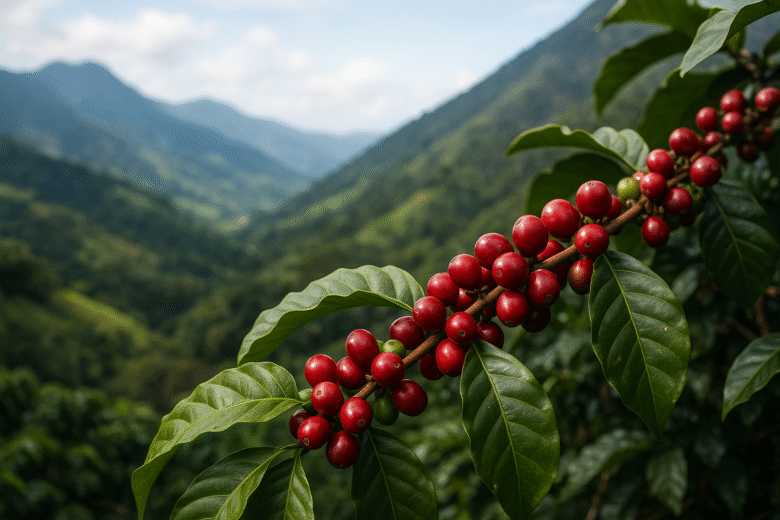Altitude plays a powerful role in shaping the flavor of coffee. It may seem like a small detail on the back of a coffee bag, but the height at which coffee is grown directly influences how it tastes in the cup.
In the world of specialty coffee, altitude isn’t just a farming statistic—it’s a predictor of quality, complexity, and flavor profile. Understanding how elevation impacts coffee gives you deeper insight into why beans from certain regions or farms taste the way they do.
This article explores how altitude affects the development of the coffee cherry, the chemical composition of the bean, and ultimately, the sensory experience of your morning brew.
What Does Altitude Mean in Coffee?
In coffee farming, altitude refers to the elevation above sea level at which the coffee plant is grown. Most specialty coffee is cultivated between 800 and 2,200 meters (or about 2,600 to 7,200 feet) above sea level.
The range matters because it affects the plant’s growth rate, bean density, and sugar development. Higher altitudes usually result in slower ripening, which allows more time for the beans to develop complex flavors.
Altitude is often listed on coffee bags and is considered a key indicator of quality in specialty coffee.
The Relationship Between Altitude and Temperature
At higher altitudes, temperatures are cooler, especially at night. This difference in temperature slows down the growth cycle of the coffee plant.
Slower growth = more time for the plant to transfer sugars, acids, and nutrients into the cherries. This leads to:
- Denser beans with more flavor
- Higher acidity and brightness in the cup
- Sweeter and more complex profiles
In contrast, coffee grown at lower altitudes matures quickly, often resulting in simpler, earthier flavors with less brightness or sweetness.
High-Altitude Coffee Flavor Profiles
Coffee grown above 1,400 meters (4,600 feet) is generally considered high-altitude. These coffees tend to be:
- Bright and acidic
- Fruity or floral
- Sweet and clean
- Complex and nuanced
Examples of high-altitude coffees include:
- Ethiopian Yirgacheffe (1,800–2,100m): floral, citrus, tea-like
- Colombian Huila (1,600–2,000m): juicy, balanced, red fruits
- Guatemalan Antigua (1,500–1,700m): spicy, chocolaty, sweet acidity
These beans are often light to medium roasted to preserve and showcase their natural complexity.
Medium-Altitude Coffee
Coffee grown between 1,000 and 1,400 meters often offers a nice balance between body and acidity.
These coffees might be:
- Nutty and chocolaty
- Smooth with medium body
- Slightly fruity or citrusy
Medium-altitude beans are versatile and approachable, making them ideal for espresso or drip brewing.
Countries like Brazil and some regions of Peru or Honduras produce excellent medium-altitude coffees.
Low-Altitude Coffee Characteristics
Beans grown below 1,000 meters (3,300 feet) tend to develop faster due to higher temperatures and less temperature variation.
This results in:
- Softer beans
- Less acidity
- More earthy or woody notes
- Higher bitterness and simpler flavors
Robusta is often grown at low altitudes, and some low-altitude Arabica is used for blends, instant coffee, or commercial-grade products.
That doesn’t mean all low-altitude coffee is bad—but it’s generally less vibrant or dynamic than high-altitude counterparts.
Bean Density and Roasting
Altitude also affects bean density, which has a big impact on how the coffee roasts.
- High-altitude beans are denser and require more energy to roast evenly. They tend to perform well at lighter roast levels, where their complexity can shine.
- Low-altitude beans are less dense, roast faster, and are often roasted darker to enhance body and mask flavor imbalances.
Roasters consider altitude when designing profiles to bring out the best in the bean.
Processing Methods and Altitude
Certain processing methods complement or enhance the traits of high-altitude coffees.
- Washed (wet) processing is commonly used at high elevations to showcase acidity and clarity.
- Natural (dry) processing can add body and fruitiness to high-altitude coffees from places like Ethiopia or Yemen.
- Honey processing balances sweetness and acidity, especially in mid-altitude coffees in Costa Rica or El Salvador.
Processing combined with altitude creates a wide range of flavors from the same plant species.
Microclimates and Terroir
Altitude doesn’t act alone. It works with microclimates—unique combinations of rainfall, wind, sunlight, and soil—that further shape the bean’s flavor.
Two farms at the same elevation can produce dramatically different coffees if one is shaded by mountains or benefits from a specific wind pattern.
This is why traceability in single-origin coffee is so exciting—it tells the story of a specific place with its own personality.
Why Altitude Matters to You
As a coffee drinker, knowing the altitude can help you:
- Predict the coffee’s flavor before brewing
- Choose beans that match your taste preferences
- Better understand the price and value of specialty coffee
- Talk with baristas and roasters more confidently
- Explore different regions with curiosity and purpose
Altitude is not the only factor, but it’s one of the most reliable indicators of a coffee’s brightness, clarity, and depth.
What to Look for on Coffee Labels
When buying beans, check for:
- Altitude (in meters or feet)
- Region or farm name
- Processing method
- Roast level
If the label lists 1,800 meters, expect high acidity and complexity. If it says 1,000 meters, look for balance and smooth body.
If no altitude is listed, it’s likely a blend or a lower-grade commercial coffee.
Debunking Altitude Myths
Not all high-altitude coffee is automatically better. Poor farming practices or bad processing can ruin good beans.
Also, some low-altitude coffees can taste great in blends or as dark roasts.
Taste is subjective. Altitude is a helpful tool—not a rule.
Use it alongside roast, origin, processing, and your own preferences to make the best choice.
Conclusion: The Higher the Bean, the Brighter the Brew
Altitude is one of the most important variables that shapes the taste of your coffee.
Higher elevations lead to sweeter, denser, more complex beans. Lower altitudes offer smoother, earthier, more straightforward flavors.
Knowing this helps you appreciate not just what’s in your cup—but how it got there.
Next time you drink a high-grown Ethiopian or a low-grown Brazilian, remember: elevation is more than just a number—it’s a story told through flavor.

Marcio Luzardo is a coffee enthusiast and the voice behind Tudo Viraliza. With a passion for turning curiosity into practical knowledge, he shares easy-to-follow tips, guides, and insights to help readers enjoy better coffee every day. When he’s not writing, Marcio is exploring new brewing methods or diving into the rich stories that connect coffee to culture, lifestyle, and wellness.



